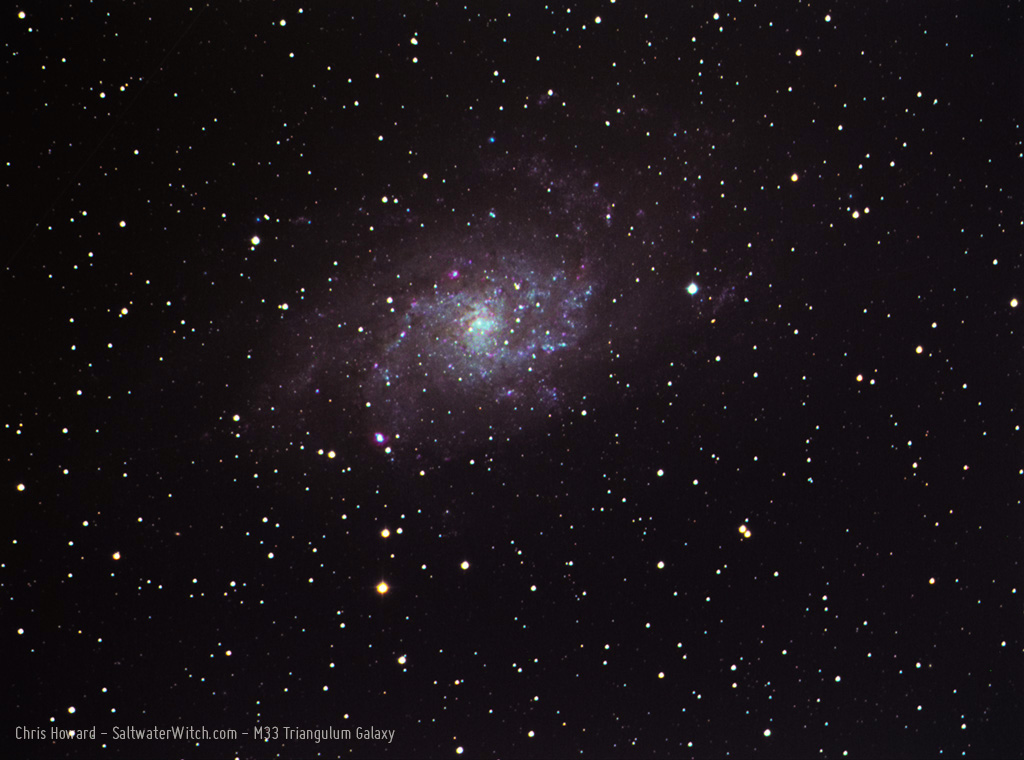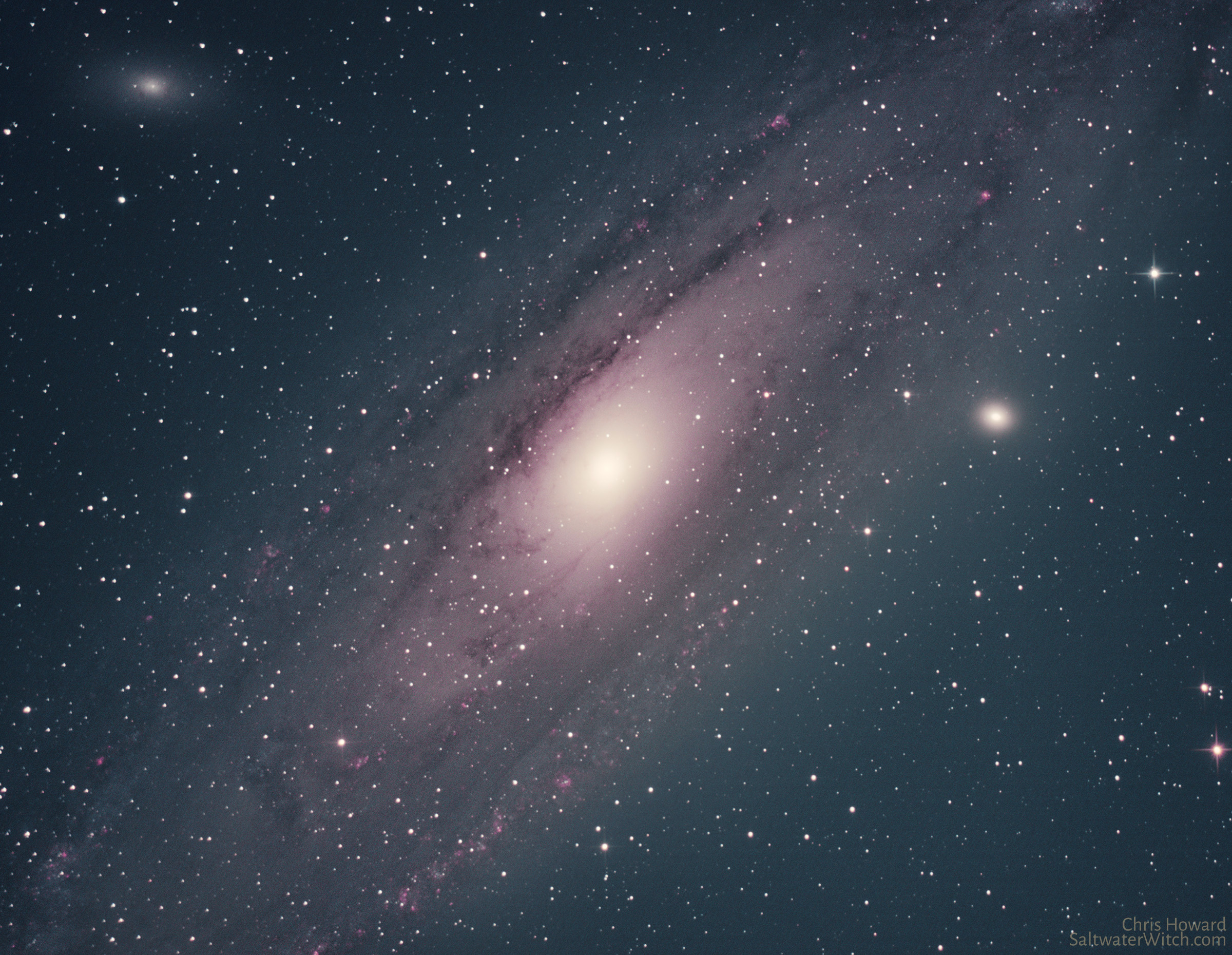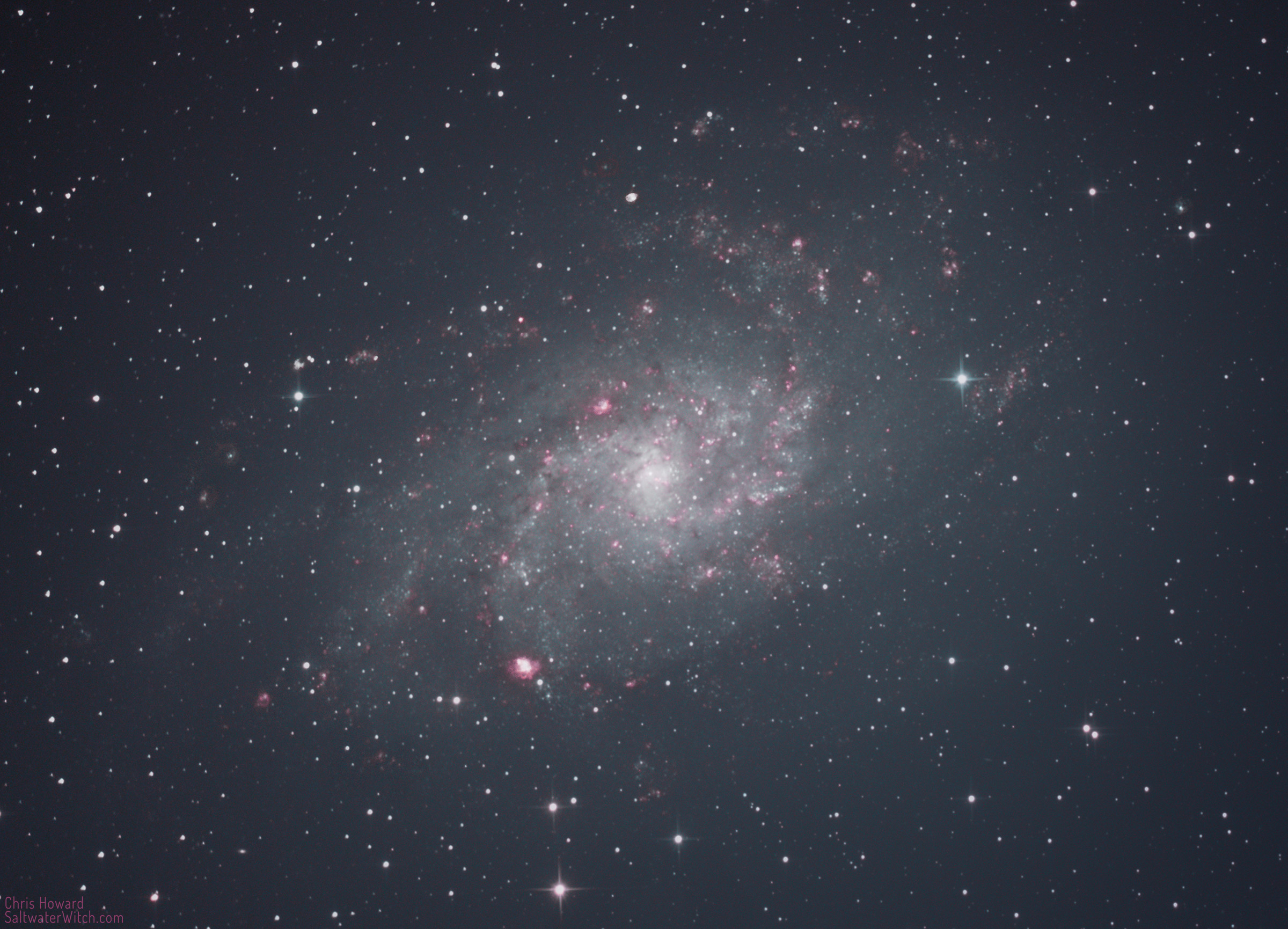M31 and M33
I used the Optolong L-eXtreme for half of the exposures, filtering out everything except 7nm lines along hydrogen-alpha and oxygen 3, and then switched to full broadband, just the UV/IR Cut Filter. Notes: 8" 800mm f/4 Newtonian and the ZWO ASI071MC cooled color camera.
I'm not really a galaxy guy, more of a nebula guy, mainly because I don't have a scope over 1350mm, which is just long enough to get a handful of nearby galaxies. So, for now, I usually capture a couple of our galactic neighbors when they swing around this time of year--and if the moon and clear night skies line up for broadband color imaging!
The central region of M31, Andromeda Galaxy:
The Triangulum Galaxy from my backyard--it's only 2.73 million light-years from Earth! I've said it before. Once we develop MFTL technology (Much Faster Than Light) and we have the ability to hop to nearby galaxies, count me in on a trip to M33, the Triangulum Galaxy. The chunky pinkish masses are vast regions of interstellar ionized hydrogen that make up the nebulae in M33, perfect for an astrophotography outing. Until then, maybe we can take a trip to the southern hemisphere? Notes: Apertura 8" Newtonian OTA--800mm at f/4, ZWO ASI071MC cooled color camera. Optolong L-eXtreme dual narrowband filter. 48 x 240-second exposures stacked in DSS.
Posted September 4, 2022
Triangulum Galaxy, Picking Favorites
M33, the Triangulum Galaxy in Ha+RGBColor with the SpaceCat51 and ZWO ASI071MC cooled color camera + Atik 414EX monochrome camera. I processed some 2018 and 2019 data to see what kind of detail I can get out NGC 604--that's the large pink mass at the middle bottom of the galaxy in this rotation. NGC 604 is a vast HII region, much brighter and 40 times larger than the Orion Nebula in our galaxy. M33 is a little under 3 million lightyears away.
Andromeda (M31) was the first deep sky object I captured with a camera--an old Nikon D40x DSLR. The Orion Nebula (M42) was the second. For many years M31 was my favorite galaxy and it is in many ways the ideal galaxy; it's a massive spiral at the perfect photographic angle from our perspective, here in the middle of our own galaxy. At two and a half million lightyears, it's not far away. And while M101, the Pinwheel Galaxy, is perfect from a galactic structure point of view, being a face-on from our perspective (or top down), Andromeda is cinematically posed for all of us taking pictures from earth. Galaxies are not really my thing. I usually focus on narrowband imaging of nebulae, supernova remnants, and other large structures within the Milky Way--so, thousands of lightyears away, not millions. I almost always shoot with sub-1000mm focal lengths, and galaxy imagers are usually running with 2000mm or more. OTAs of 3000mm and up are common.
Andromeda is certainly one of my favorites, but I think the Triangulum Galaxy (Messier 33, M33, NGC 598) in the constellation Triangulum is my favorite northern hemisphere galaxy. It's kind of chunky with vast HII regions (the pink structures scattered along the spiral arms). It gets a little thin out toward the edges; not the smooth plane of stars you see in the Andromeda galaxy. It's made up of 40 billion stars rather than the trillion or so in Andromeda. M33 is another galactic neighbor and close enough to capture with medium focal lengths.
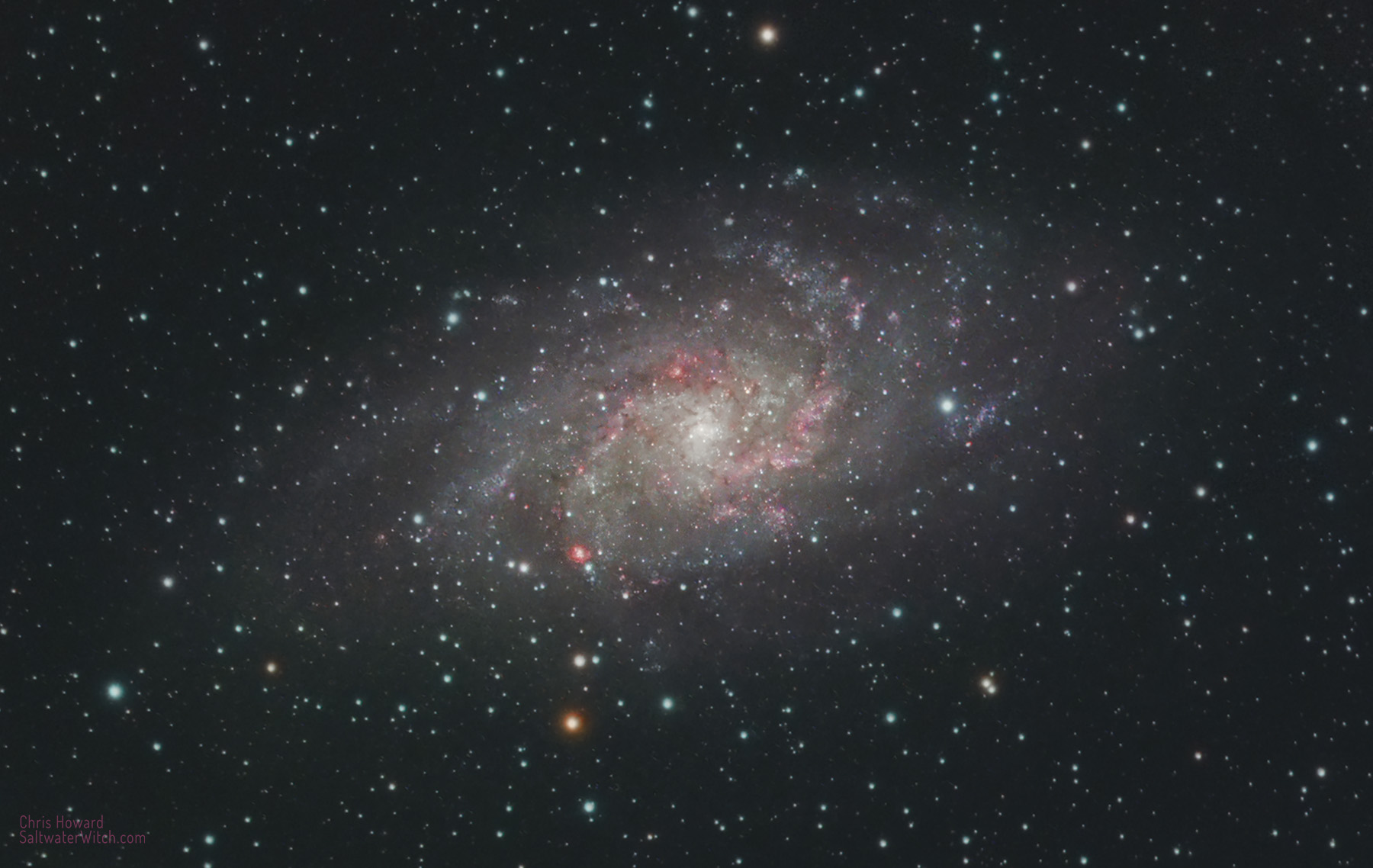
Posted May 9, 2022
Astro Session: October 30, 2018
I had several hours of clear skies, still relatively dark before the moon rose, and I set up the William Optics GT81 and ZWO ASI071MC color camera to take a bunch of subs of M33 and M45--Triangulum Galaxy and the Pleiades, two of my favorite targets this time of year--but this is my first time shooting these with the ZWO ASI071MC cooled color camera, and the resulting images show how amazing the ZWO is. (ZWO ASI071MC running at -10C, William Optics GT81 + WO Flat 6A II f/4.7, iOptron CEM25P EQ mount, Orion OAG + ZWO ASI120MM-S guide cam, Stellarmate OS (INDI/KStars/Ekos) running on Raspberry Pi 3b+).
The Pleiades, M45, also known as "The Seven Sisters" and in Japanese as Subaru (昴). It's one of the most identifiable objects in the night sky, but it's more than just a loose group of stars. Located in the constellation Taurus, the Pleiades is a nearby open star cluster mostly made up of a batch of relatively young B-type stars amid (or behind) a reflection nebula that appears to surround and fill the space between the stars with veil-like sheets and threads. (WilliamOptics GT81, ZWO ASI071MC: 60 x 60 second and 60 x 120 second exposures, unity gain).
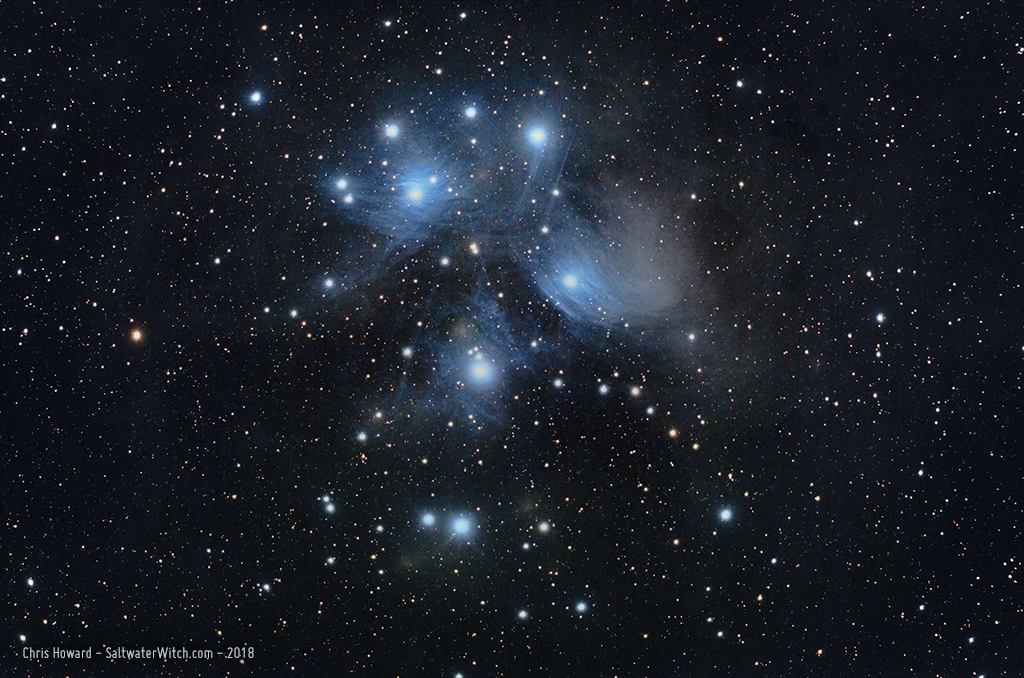
Triangulum Galaxy, M33, is a nearby spiral galaxy--around 3 million lightyears away, with as many as 40 billion stars. It's the third largest galaxy in our local group, and appears to be bound up in Andromeda's gravitational pull. It also contains some amazing nebulae and other deep space objects, e.g., NGC 604 is a massive H II region--that's the bright pinkish blob, the size of a large star, at the lower left side of the galactic spiral. Keep in mind that nearly every star-like point of light in this image is actually a star in the Milky Way, our own galaxy. (WilliamOptics GT81, ZWO ASI071MC: 90 x 60 second exposures, unity gain).
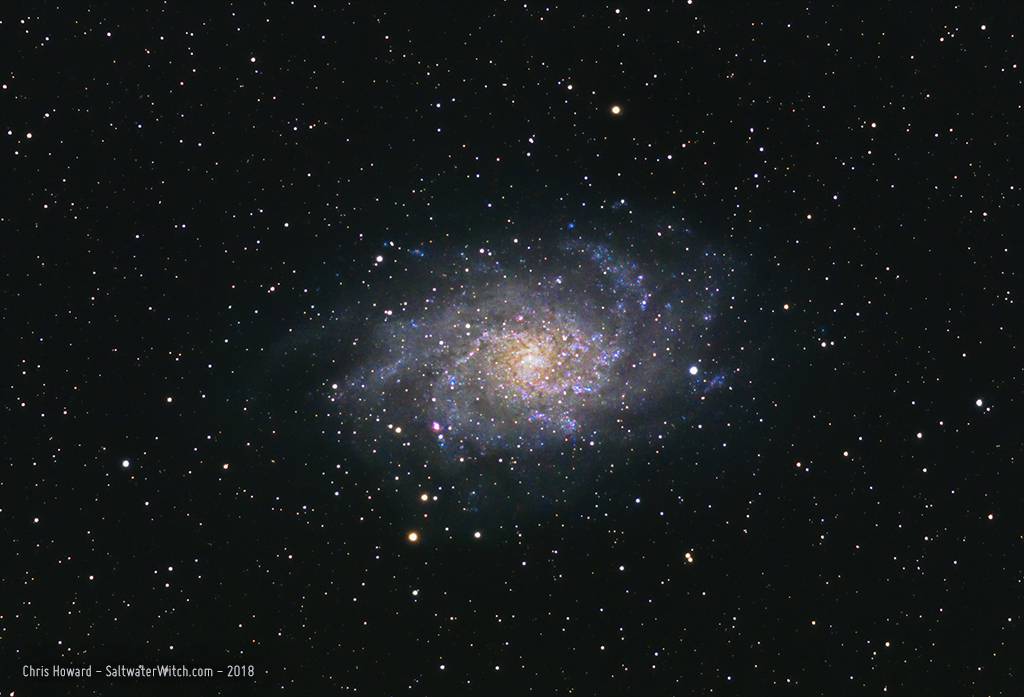
Posted October 30, 2018
Astro Session - November 10, 2017
M33 Triangulum Galaxy, about 3 million lightyears away, so... not that far. M33 is a relatively small spiral galaxy with only 40 billion stars. I'm having some trouble with my guide camera (ZWO ASI120MM), so this is all unguided. I took 80 LRGB exposures--120 seconds each, 10 Ha frames at 120 secs, 20 dark calibration frames, stacked in DSS).
